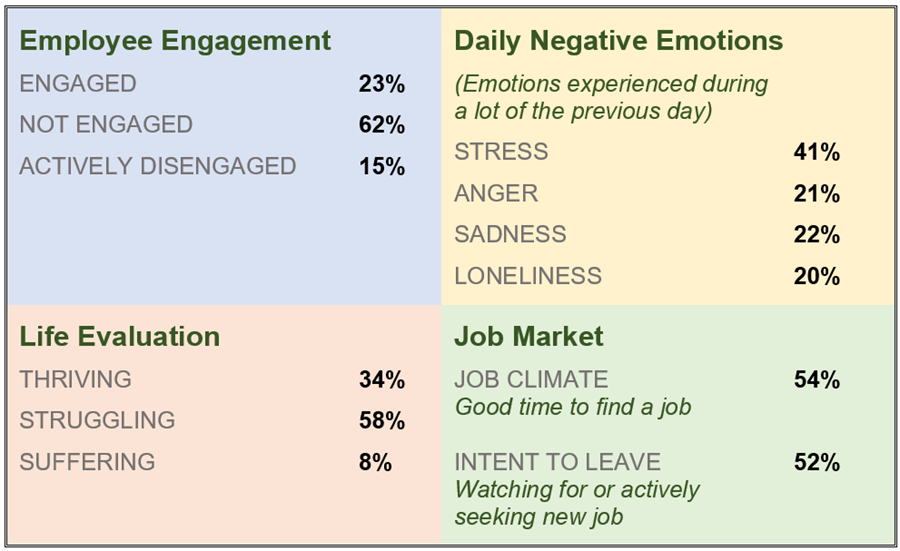Employees are feeling lonelier, wellbeing amongst younger employees has dropped, and employee
engagement remains a significant factor in overall life experiences as always. Here’s a complete roundup of the Gallup State of the Global Workplace report for 2024.

Gallup’s State of the Global Workplace report for 2024 provides insights into the current state of mental health, impact of economic and policy factors, and the influence of managerial practices on employee wellbeing. The report also identifies overarching trends that reveal the diverse effects employment has on workers. The findings will enable employers across all sectors to make informed, targeted decisions on prioritizing the wellbeing of their people.
Focus on Mental Health
Subtitled The Voice Of The World’s Employees, the 2024 report surveyed more than 128,000 employees from 160 countries. It offers a comprehensive overview of employee satisfaction across a diverse range of occupations and industries. In his forward, Gallup CEO Jon Clifton, writes, “The global workplace can play a significant role in addressing the world’s mental health crisis. As detailed in this year’s report, changing how we manage people is critical for reducing stress at work and in life.”
Gallup’s report this year is in sync with the official theme for World Mental Health Day 2024. Held annually by the World Federation for Mental Health, it was observed on 10 October 2024, and the theme was “It is time to prioritise mental health in the workplace”. According to Tsuyoshi Akiyama, WFMH President, the goal is “…to champion mental health in the workplace and build best practices that create cultures where workers have the potential to contribute productively and thrive.”
Employee Categories and Well-Being Levels
Gallup classifies employees into three categories: engaged, not engaged, and actively disengaged.
- Engaged employees are flourishing at work. They exhibit high levels of involvement and enthusiasm for their roles and workplace. They take ownership of their responsibilities, drive performance and innovation, and contribute significantly to the organisation’s progress.
- Not engaged employees are essentially “quietly quitting.” They lack a psychological connection to their work and the company. As their engagement needs remain unmet, they fulfil their job requirements without putting in energy or passion.
- Actively disengaged employees are making their discontent known. Their unhappiness at work is accompanied by resentment over unmet needs, leading them to express their dissatisfaction. These individuals can potentially undermine the achievements of their engaged colleagues.
The report also categorises respondents based on their levels of well-being: thriving, struggling, and suffering. Those who rated their current life situation positively (7 or higher) and expressed optimism for the next five years are deemed “thriving.” Conversely, individuals with uncertain or negative perspectives regarding their current and future circumstances, often marked by stress and financial concerns, are classified as “struggling” or “suffering.”
Report Structure
Going past the note from the CEO, an Executive Brief, and a one-page Research Summary, the main analytical body of the report is divided into three parts:
- Part I: Employee Mental Health: A Global Snapshot
- Part II: The Role of Economics and Policy in the Wellbeing of Workers
- Part III: The Role of the Manager in Worker Wellbeing and Organisational Performance
Let’s take a quick glance at each.
Part I – Mental Health
The findings in this part have been captured in three crisp summary points, as follows:
- Twenty percent of the world’s employees experience daily loneliness.
- Wellbeing among younger employees dropped in 2023.
- Employee engagement is a significant factor in overall life experiences.
The loneliness percentage was higher for employees under 35 compared to those above 35. Fully remote workers reported a loneliness rate of 25%, which was significantly higher than fully on-site employees (16%). Overall, working adults are less lonely (20%) than the unemployed (32%), a trend consistent across age groups.
In terms of wellbeing, Gallup’s measures indicate a global decline in employee wellbeing from 35% to 34%, particularly affecting younger workers. Those who disliked their jobs experienced high daily stress, worry, and negative emotions. Actively disengaged employees demonstrated wellbeing challenges similar to or worse than those who are unemployed. Conversely, half of the engaged employees reported to be thriving in life overall.
Part II – Economics and Policy
The summary points for this part are:
- Countries where it is a good time to find a job have lower active disengagement.
- Labour protections are associated with employees evaluating their present overall life better.
- Independent of labour laws, employee engagement is associated with hope for the future.
- Engaged employees in countries with substantial Labour Rights laws have the strongest emotional health.
Actively disengaged employees – those who oppose their employer’s goals – make up 15% of the global workforce. Economic conditions significantly influence this disengagement, with poor job markets correlating strongly with it. The report suggests that increased job opportunities enable dissatisfied employees to leave toxic work environments for better options.
Strong labour laws in the country positively impacted individuals’ current life satisfaction more than their future optimism. Conversely, labour laws appeared to have a stronger relationship to current satisfaction than optimism for the future. Engaged employees, however, tend to have significantly greater hope for their futures, regardless of the legal framework. Even in countries with similar labour protections, employee experiences can vary widely. Additionally, individuals within the same country may face very different workplace environments. A combination of robust labour protections and high employee engagement correlates with lower levels of negative daily emotions.
Part III – Role of the Manager
This part is summarized in the following three points:
- Managers have more negative experiences than non-managers.
- When managers are engaged, employees are more likely to be engaged.
- In best-practice organizations, three-fourths of managers are engaged, along with seven in ten non-managers.
Managers are typically more likely to feel engaged and thriving – with higher pay and social status, organizational clout, and support. However, they face greater stress, anger, sadness, and loneliness levels compared to non-manager counterparts. Despite the advantages of their roles, managers experience more negative emotions and are more inclined to seek new job opportunities.
Importantly, when managers are engaged at work, it positively influences non-managers’ engagement as well. This correlation is evident at the country level; nations with higher manager engagement see non-managers twice as likely to be engaged. The findings indicate that 70% of team engagement variance is linked to managerial effectiveness.
Globally, only 30% of managers and 23% of the overall workforce are engaged, but some organizations achieved significantly higher engagement levels. Best-practice organizations reported 75% of managers and 70% of non-managers to be engaged and thriving.
Data, Graphs, and Appendices
The subsequent portion of the report comprises extensive data-graphs based on the research findings. These are grouped into chapters structured as follows:
- Global Insights
- Regional Insights (United States and Canada; Latin America and the Caribbean; Europe; Post-Soviet Eurasia; Middle East and North Africa; Sub-Saharan Africa; East Asia; South Asia; Southeast Asia; Australia and New Zealand)
- Appendix 1: Country/Region Comparisons
- Appendix 2: Methodology
- Appendix 3: Support Information
- Appendix 4: Labour Rights Index
Regional Insights – South Asia
Under the Regional Insights analysis, the South Asia region comprises Afghanistan, Bangladesh, India, Nepal, Pakistan and Sri Lanka. The report summarizes the top takeaways for this region as follows:
- Lowest regional percentage of thriving employees
- Highest regional percentage of employees experiencing daily loneliness
- Highest regional percentage of employees experiencing daily anger
The Indian Scenario
Following are the India-specific statistics that feature in the report under the Regional Insights analysis for South Asia:
- Employee Engagement: India stands first at 32% Engaged. Pakistan is at the lowest (7%).
- Life Evaluation: India stands second at 14% Thriving, right after Nepal (22%).
- Daily Stress: India scores the lowest at 32% admitting to stress, with Sri Lanka at the top (62%).
- Daily Anger: India is at the top with 35% admitting to daily anger. Nepal is at the lowest (25%).
- Daily Sadness: India stands third with 42% admitting to daily sadness, after Afghanistan (48%) and Bangladesh (47%).
- Job Climate: India stands second with 57% thinking this to be a good time to find a job in the city or area of residence. Nepal tops (47%).
- Intent to Leave: India stands third with 52% watching for or actively seeking a new job, after Bangladesh (67%) and Pakistan (57%).
—
The Gallup State of the Global Workplace Report, 2024, serves as a wake-up call, much like all previous Gallup findings. The results emphasize an urgent need to focus on mental health and overall well-being. Policymakers and employers across the world must prioritize the holistic well-being of the workforce. Any reluctance in promptly addressing these issues could have long-term negative effects on the global work environment.


